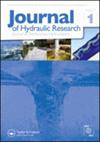Natural convection due to surface cooling in sloping water bodies with vegetation
IF 1.7
3区 工程技术
Q3 ENGINEERING, CIVIL
引用次数: 0
Abstract
Natural convection induced by surface cooling in sloping water bodies with vegetation is investigated numerically. The sloping water body consists of a vegetated region with a bottom slope equal to 0.1 and a deep region with a horizontal bottom. The volume-averaged Navier–Stokes equations together with the volume-averaged energy equation are solved numerically in the vegetated region. Submerged vegetation has an equivalent porosity of 0.85. The vegetation length is either equal to the total or half the sloping region. A differential cooling is applied at the top free surface with a varying heat loss rate between the two regions. The non-vegetated sloping water body is also considered for validation purposes. The results indicate that, when cooling is reduced in the vegetated region (a) there is a time delay for the establishment of the quasi-steady regime and (b) the exchange flow rate and the gravity current's velocity decreases with increasing vegetation length. When cooling is completely blocked, different circulation patterns are developed.有植被的倾斜水体表面冷却引起的自然对流
本文对有植被的倾斜水体中地表冷却引起的自然对流进行了数值研究。倾斜水体由底部坡度为0.1的植被区和底部水平的深水区组成。在植被区对体积平均Navier-Stokes方程和体积平均能量方程进行了数值求解。淹没植被的等效孔隙度为0.85。植被长度或等于坡地总面积,或等于坡地面积的一半。在顶部自由表面应用微分冷却,两个区域之间的热损失率不同。为了验证目的,还考虑了无植被的倾斜水体。结果表明:当植被区降温减少时,(a)准稳态区建立存在时滞;(b)交换流速率和重力流速度随植被长度的增加而减小。当冷却完全阻塞时,就会形成不同的循环模式。
本文章由计算机程序翻译,如有差异,请以英文原文为准。
求助全文
约1分钟内获得全文
求助全文
来源期刊

Journal of Hydraulic Research
工程技术-工程:土木
CiteScore
4.90
自引率
4.30%
发文量
55
审稿时长
6.6 months
期刊介绍:
The Journal of Hydraulic Research (JHR) is the flagship journal of the International Association for Hydro-Environment Engineering and Research (IAHR). It publishes research papers in theoretical, experimental and computational hydraulics and fluid mechanics, particularly relating to rivers, lakes, estuaries, coasts, constructed waterways, and some internal flows such as pipe flows. To reflect current tendencies in water research, outcomes of interdisciplinary hydro-environment studies with a strong fluid mechanical component are especially invited. Although the preference is given to the fundamental issues, the papers focusing on important unconventional or emerging applications of broad interest are also welcome.
 求助内容:
求助内容: 应助结果提醒方式:
应助结果提醒方式:


